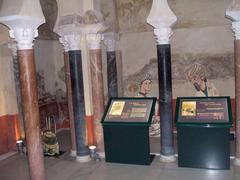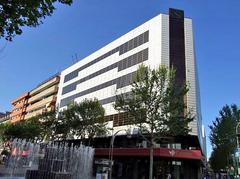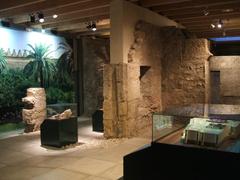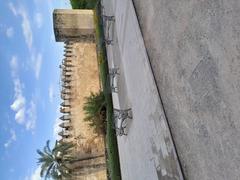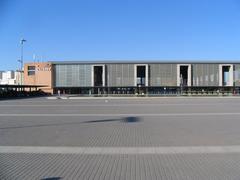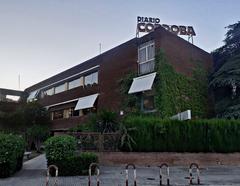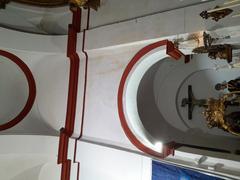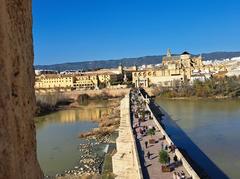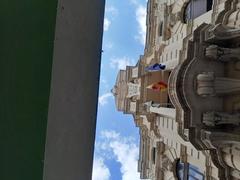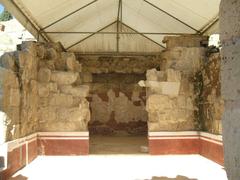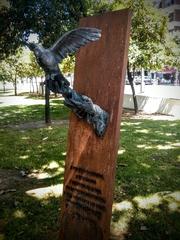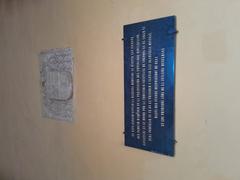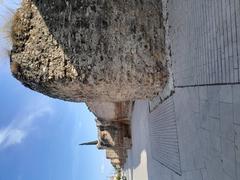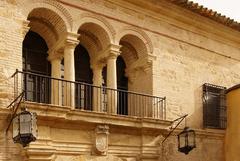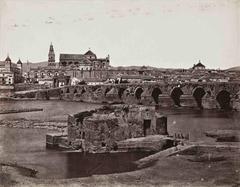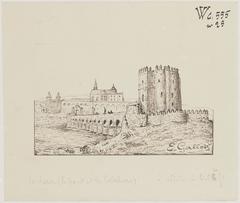Museum of Fine Arts of Córdoba: Visiting Hours, Tickets, and Complete Guide to Córdoba’s Historical Sites
Date: 15/06/2025
Introduction
The Museum of Fine Arts of Córdoba (Museo de Bellas Artes de Córdoba) is an essential destination for anyone interested in Andalusian art, Spanish history, or cultural exploration. Located in the heart of Córdoba’s historic center at Plaza del Potro, this museum provides an immersive journey through seven centuries of artistic achievement. From its origins amid Spain’s 19th-century efforts to preserve provincial heritage, to its present role as a vibrant hub for exhibitions and education, the museum stands out as a cornerstone of Córdoba’s cultural landscape. This comprehensive guide covers everything you need to know: visiting hours, ticketing, accessibility, top collection highlights, travel tips, and how to make the most of your visit to Córdoba’s historical sites (Explorial, tocordoba.com, Spain.info).
Table of Contents
- Historical Overview
- Thematic Organization and Exhibition Spaces
- Visitor Information
- Nearby Historical Sites and Cultural Integration
- Essential Visit Tips
- Frequently Asked Questions (FAQ)
- Visuals and Media Recommendations
- Conclusion and Call to Action
- Sources
Historical Overview
Origins and Foundation
The Museum of Fine Arts of Córdoba was founded in 1862 as part of Spain’s national initiative to safeguard provincial artistic heritage following the 1835 desamortización—a wave of secularization and redistribution of church property (tocordoba.com). Early collections were gathered by local intellectuals and artists, with a focus on preserving works from convents and religious institutions.
Architectural Heritage: Hospital de la Caridad
Since 1862, the museum has been housed in the former Hospital de la Caridad, an architectural jewel originally constructed in the late 15th century. The building features Renaissance and Plateresque elements, an elegant courtyard with orange trees, and a Baroque staircase with a stunning wooden coffered ceiling (sientecordoba.com). Declared a monument of Cultural Interest in 1962, it provides an atmospheric setting that enhances the art-viewing experience (Artencordoba).
Institutional Evolution
Initially managed by local authorities, the museum became part of the National Museums Board in 1978 and, since 1984, has been under the stewardship of the Ministry of Culture of the Junta de Andalucía. This transition ensured its integration into regional and national cultural policies (Artencordoba).
Collection Development and Artistic Focus
The museum’s collection traces the full arc of Andalusian and Spanish art, from the 14th century to the present. Particular emphasis is placed on Baroque, Romantic, and contemporary works by Cordoban and Andalusian masters. The acquisition policy prioritizes works with strong local or regional connections (Spain.info).
Key artists include:
- Pablo de Céspedes (Renaissance painter and humanist)
- Antonio del Castillo (Baroque master)
- Valdés Leal, Ribera, Murillo, Luis de Morales, Zurbarán (Baroque luminaries)
- Mateo Inurria (Sculpture)
- Julio Romero de Torres (Symbolist painter, whose main works are in the adjacent museum)
- Rafael Romero Barros (first director, father of Julio Romero de Torres)
The museum also maintains a notable collection of drawings and works on paper, often shown in temporary exhibitions (Google Arts & Culture).
Thematic Organization and Exhibition Spaces
Galleries are organized chronologically and thematically:
- Medieval & Renaissance Art: Works by Pedro Romana, Alejo Fernández, Pedro de Campaña, and Pablo de Céspedes.
- Baroque & Golden Age: Paintings by Juan de Peñalosa, Antonio del Castillo, Antonio García Reinoso, Valdés Leal, and Juan de Alfaro. Sculptures by Juan de Mesa and Verdiguier are also featured.
- 19th Century Romanticism & Realism: Works by Rafael Romero Barros, Rafael Romero de Torres, and others.
- 20th Century & Modern Art: Pieces by Julio Romero de Torres, Ignacio Zuloaga, José Gutiérrez Solana, Daniel Vázquez Díaz, Antoni Tàpies, Eduardo Chillida, Rafael Canogar, and Antonio Saura.
- Works on Paper: Rotating exhibitions of sketches, prints, and drawings.
The museum’s layout encourages visitors to follow the evolution of Andalusian art across centuries, from ground-floor medieval works to upper-level contemporary pieces (Wikipedia).
Visitor Information
Visiting Hours
- Summer (July–August):
- Tuesday to Saturday: 9:00 AM – 9:00 PM
- Sundays and Public Holidays: 9:00 AM – 3:00 PM
- Winter (September–June):
- Tuesday to Sunday and Public Holidays: 9:00 AM – 3:00 PM
- Closed: Mondays and specific holidays (January 1st and 6th, May 1st, December 24th, 25th, 31st)
Always check the official website for up-to-date schedules.
Tickets and Admission
- EU Citizens: Free (with valid ID)
- General Admission: €1.50 for non-EU visitors
- Reductions: Free for children under 18, students, seniors over 65, and people with disabilities (WhichMuseum ticket info)
- Groups: Booking recommended for groups; inquire about guided tours and discounts
Tickets are available at the entrance and, while crowds are rare, advance group bookings are advised.
Accessibility and Facilities
- Wheelchair Access: Ramps and elevators provide access to most areas; accessible restrooms are available.
- Assistance: Wheelchairs may be requested at the entrance.
- Cloakroom: Store coats, bags, and umbrellas. Large items are not permitted in exhibition spaces.
- Restrooms: Located on the ground floor with adapted facilities.
- Museum Shop: Books, postcards, and art-themed gifts are available.
- Language: Signage in Spanish and English; guided tours primarily in Spanish, sometimes available in English.
Tours and Special Events
- Guided Tours: Offered in Spanish and occasionally English; advance booking recommended for groups.
- Educational Programs: Workshops and activities for children and schools are available during festivals and holidays.
- Temporary Exhibitions: Regularly scheduled; check the event calendar for current offerings.
Nearby Historical Sites and Cultural Integration
The museum sits within Córdoba’s UNESCO-listed historic center and is closely integrated with the city’s vibrant cultural network:
- Julio Romero de Torres Museum: Shares the same building complex, dedicated to Córdoba’s famous painter.
- Plaza del Potro: Historic square mentioned in “Don Quixote,” home to the Posada del Potro and Triumph of San Rafael.
- Mosque-Cathedral of Córdoba: Iconic site of Islamic and Christian heritage.
- Archaeological Museum of Córdoba: Artifacts tracing Córdoba’s ancient roots.
- Palacio de Viana: Renowned for its patios and gardens.
Combine your museum visit with a stroll to these nearby attractions for a comprehensive cultural itinerary (whichmuseum.com).
Essential Visit Tips
- Best Times: Weekday mornings or late afternoons are quietest.
- Photography: Non-flash photography for personal use is allowed; professional equipment requires authorization.
- Dress and Conduct: No formal dress code, but respectful attire is expected. Food, drink, and loud conversations are not permitted in the galleries.
- Duration: Most visits take 60–90 minutes.
- Dining: Numerous cafés and tapas bars are within a five-minute walk of the museum.
- Sustainability: The museum employs energy-efficient lighting and waste reduction practices; visitors are encouraged to respect the site and its collections.
Frequently Asked Questions (FAQ)
Q: What are the Museum of Fine Arts of Córdoba visiting hours?
A: Summer: Tuesday–Saturday, 9:00 AM–9:00 PM; Sundays/holidays, 9:00 AM–3:00 PM. Winter: Tuesday–Sunday/holidays, 9:00 AM–3:00 PM. Closed Mondays.
Q: How much are tickets?
A: €1.50 for non-EU visitors; free for EU citizens, children under 18, students, seniors, and people with disabilities.
Q: Is the museum wheelchair accessible?
A: Yes, most galleries are accessible; accessible restrooms and wheelchairs are available.
Q: Are guided tours offered in English?
A: Primarily in Spanish, sometimes in English. Check availability in advance.
Q: Can I take photos inside?
A: Yes, non-flash photography is allowed for personal use.
Q: What other attractions are nearby?
A: The Julio Romero de Torres Museum, Plaza del Potro, Mosque-Cathedral, Archaeological Museum, and Palacio de Viana are all within walking distance.
Visuals and Media Recommendations
- Images: Include high-resolution photos of the museum’s Renaissance facade, interior courtyards, and key works by Antonio del Castillo, Pablo de Céspedes, and Julio Romero de Torres.
- Alt Tags: Use descriptive tags for SEO, e.g., “Museum of Fine Arts of Córdoba facade,” “Baroque painting in Córdoba museum.”
- Digital Resources: Explore virtual tours and digital collections via Google Arts & Culture.

Conclusion and Call to Action
The Museum of Fine Arts of Córdoba is a vital stop for anyone seeking to understand the artistic and cultural evolution of Andalusia. With its accessible facilities, rich collections, and integration into Córdoba’s historic center, it offers an unparalleled cultural experience. Plan your visit for a weekday morning or late afternoon, reserve a guided tour if possible, and take advantage of the museum’s proximity to Córdoba’s other major attractions. For up-to-date news, special events, and digital resources, check the official website or download the Audiala app for audio guides and exclusive content.
Enhance your cultural journey in Córdoba: explore related articles, follow us on social media, and use the Audiala app for insider tips and guided tours!
Sources
- Explorial – Museum of Fine Arts of Córdoba Guide
- tocordoba.com – Museum of Fine Arts of Córdoba
- Spain.info – Museum of Fine Arts of Córdoba
- WhichMuseum – Museum of Fine Arts of Córdoba
- Google Arts & Culture – Museum of Fine Arts of Córdoba
- Museos de Andalucía – Official Museum Website
- sientecordoba.com – Fine Arts Museum Córdoba
- Artencordoba – Museo de Bellas Artes de Córdoba
- Wikipedia – Museum of Fine Arts of Córdoba
